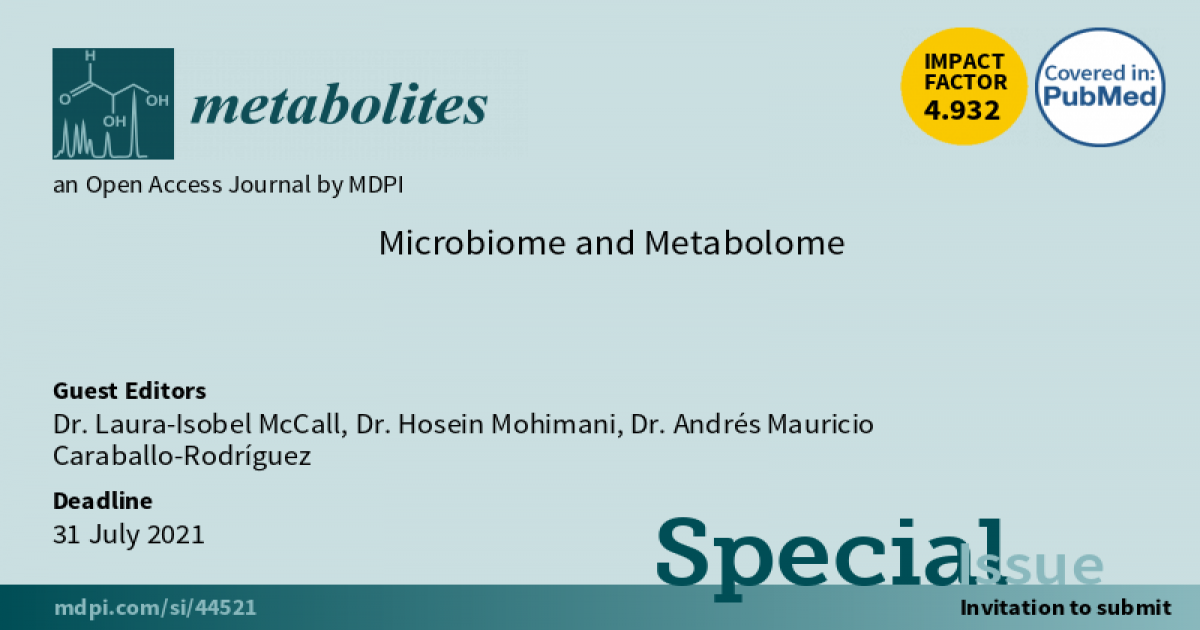Microbiome and Metabolome
A special issue of Metabolites (ISSN 2218-1989). This special issue belongs to the section "Environmental Metabolomics".
Deadline for manuscript submissions: closed (31 July 2021) | Viewed by 39605

Special Issue Editors
Interests: metabolomics; chemical cartography; host–microbe interactions; LC–MS; microbiome
Interests: computational metabolomics and metagenomics; natural product discovery; microbiome analysis
Special Issues, Collections and Topics in MDPI journals
Interests: natural products; small molecules; metabolomics; mass spectrometry; chemical ecology
Special Issues, Collections and Topics in MDPI journals
Special Issue Information
Dear Colleagues,
The microbiota, the community of microorganisms living on or in a given environment, is now widely acknowledged as a key determinant of health, disease, and organismal and ecosystem function. However, the mechanisms by which it does so remain poorly understood. Several small-molecule signals have been identified as mediators of this interaction, including short-chain fatty acids, secondary bile acids, amino acid metabolites, etc., but additional signals are clearly involved. Metabolomics is thus uniquely poised to define the chemical signals through which host and microbiota interact. Likewise, community living requires significant metabolic adaptations within microorganisms and considerable collaborative and competitive metabolic interactions between microbiota members in the environment and in hosts. This Special Issue of Metabolites, “Microbiome and Metabolome”, is dedicated to studies using metabolomics approaches to address these issues, and on novel data analysis approaches used to generate insight into these interactions. Multi-omics approaches integrating metabolomics with metagenomics, metatranscriptomics, or metaproteomics are of particular interest.
Dr. Laura-Isobel McCall
Dr. Hosein Mohimani
Dr. Andrés Mauricio Caraballo-Rodríguez
Guest Editors
Manuscript Submission Information
Manuscripts should be submitted online at www.mdpi.com by registering and logging in to this website. Once you are registered, click here to go to the submission form. Manuscripts can be submitted until the deadline. All submissions that pass pre-check are peer-reviewed. Accepted papers will be published continuously in the journal (as soon as accepted) and will be listed together on the special issue website. Research articles, review articles as well as short communications are invited. For planned papers, a title and short abstract (about 100 words) can be sent to the Editorial Office for announcement on this website.
Submitted manuscripts should not have been published previously, nor be under consideration for publication elsewhere (except conference proceedings papers). All manuscripts are thoroughly refereed through a single-blind peer-review process. A guide for authors and other relevant information for submission of manuscripts is available on the Instructions for Authors page. Metabolites is an international peer-reviewed open access monthly journal published by MDPI.
Please visit the Instructions for Authors page before submitting a manuscript. The Article Processing Charge (APC) for publication in this open access journal is 2700 CHF (Swiss Francs). Submitted papers should be well formatted and use good English. Authors may use MDPI's English editing service prior to publication or during author revisions.
Keywords
- metabolomics
- microbiome
- microbiota
- multi-omics
- environmental microbiota
- host-associated microbiota
- cross-species communication
- microbial community metabolism
- metabolic adaptation
- secondary metabolites
Benefits of Publishing in a Special Issue
- Ease of navigation: Grouping papers by topic helps scholars navigate broad scope journals more efficiently.
- Greater discoverability: Special Issues support the reach and impact of scientific research. Articles in Special Issues are more discoverable and cited more frequently.
- Expansion of research network: Special Issues facilitate connections among authors, fostering scientific collaborations.
- External promotion: Articles in Special Issues are often promoted through the journal's social media, increasing their visibility.
- e-Book format: Special Issues with more than 10 articles can be published as dedicated e-books, ensuring wide and rapid dissemination.
Further information on MDPI's Special Issue policies can be found here.








